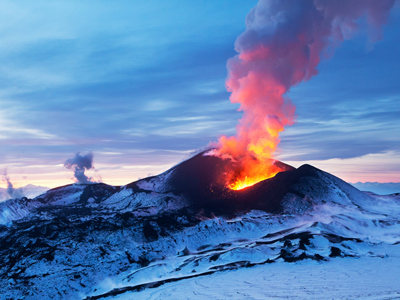
Ask the AI Tutor
Need help with Volcanoes at the Edge of Tectonic Plates? Ask our AI Tutor!
AI Tutor - Lucy
Connecting with Tutor...
Please wait while we establish connection

See if you can get full marks in this quiz.
Volcanoes at the Edge of Tectonic Plates
Volcanoes at plate boundaries release molten rock, ash, and gas. This quiz helps you revise where they form, why they erupt, and the hazards they create.
1 .
Volcanic eruptions are often seen as being negative, however, they can have some positive effects on an area. Which of the following is NOT a positive effect for a volcanic area?
Dramatic scenery can attract tourists
Ash from volcanic eruptions near the sea attracts more fish as they feed from the extra nutrients that dissolve into sea water
The high level of heat in the ground near to volcanoes can provide the hot water for geothermal energy
Certain types of ash and lava break down to provide nutrients for soil
Geothermal energy is a renewable resource. We made up the answer about the fish!
2 .
What else comes out of a volcano as well as lava?
Liquid water
Ash and gases
Ice particles
Fossils
Even volcanoes with runny lava send ash clouds high into the air, a good example of this is the 2010 eruptions of Eyjafjallajökull in Iceland. There was so much ash sent high into the air that many aircraft flights were cancelled for safety
3 .
What is the name given to magma that flows out of a volcano onto the Earth's crust?
Igneous rock
River rock
High density magma
Lava
The type of igneous rock that is formed depends on the chemical composition of the magma
4 .
Which of the following is NOT a reason why more people might die when a volcano erupts in an LEDC?
The ash cloud blots out the sunlight, killing crops and leading to starvation
Low literacy skills
Not everyone has a radio or TV
Poor communications infrastructure
People with low literary skills will not be able to read leaflets and posters telling them what to do. Some people in LEDCs are too poor to be able to afford radios and TVs so they don't get the early warnings. Poor communications infrastructure means that warnings might not reach everyon in the danger zone and if it does, the poor road network makes evacuation harder
5 .
What type of magma occurs in volcanoes at constructive plate boundaries?
High viscosity magma
Superheated magma
Low viscosity magma
Supercooled magma
Low viscosity means more it is runny. The magma from volcanoes found at this type of plate boundary comes directly from the mantle and can flow long distances before it cools and solidifies
6 .
What is a destructive plate boundary?
Where one plate is being pushed back down into the mantle
Where two plates are moving apart, destroying the area between them
Where two plates are moving sideways past each other
Where new land is being formed and then eroded quickly by the sea and earthquakes
As the plate is pushed down into the mantle it gradually melts - the mantle is very hot, at least 500°C where it meets the crust
7 .
What type of magma usually occurs in volcanoes at destructive plate boundaries?
Superheated viscosity
Ashless viscosity
Low viscosity
High viscosity
The molten rock from the plate that is being destroyed is mixed with many other types of rock on its journey to the surface
8 .
Which of the following is a primary effect of a volcanic eruption?
Ash blocking rivers causing crop destruction by flooding
Lava flow destroying property
Debris carried by rivers damaging bridges
Silting up of harbours caused by ash carried away from the area where the eruption happened by rivers
Primary effects are effects that have been caused directly by the eruption
9 .
What is a constructive plate boundary?
Where plates move apart
Where plates move together
Where plates move sideways past each other
Where the plates are not moving
It is also sometimes called a diverging plate boundary
10 .
Where do volcanoes occur?
In well defined narrow belts around the world
Randomly around the surface of the Earth
Only on land
On small islands
These belts are where plates meet
**Unlimited Quizzes Await You! 🚀**
Hey there, quiz champ! 🌟 You've already tackled today's free questions.
Ready for more?
Ready for more?
🔓 Unlock UNLIMITED Quizzes and challenge yourself every day. But that's
not all...
not all...
🔥 As a Subscriber you can join our thrilling "Daily Streak" against other
quizzers. Try to win a coveted spot on our Hall of Fame Page.
quizzers. Try to win a coveted spot on our Hall of Fame Page.
Don't miss out! Join us now and keep the fun rolling. 🎉
**Unlimited Quizzes Await You! 🚀**
Hey there, quiz champ! 🌟 You've already tackled today's free questions. Ready for more?
🔓 Unlock UNLIMITED Quizzes and challenge yourself every day. But that's not all...
🔥 As a Subscriber you can join our thrilling "Daily Streak" against other quizzers. Try to win a coveted spot on our Hall of Fame Page.
Don't miss out! Join us now and keep the fun rolling. 🎉






